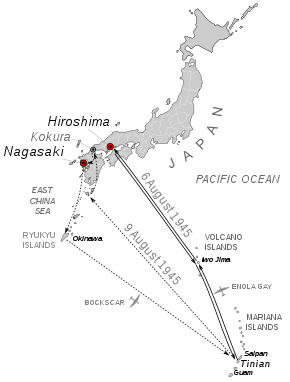Enola Gay
Enola Gay participated in the second nuclear attack as the weather reconnaissance aircraft for the primary target of Kokura.
The bomber was one of the first fifteen B-29s built to the "Silverplate" specification— of 65 eventually completed during and after World War II—giving them the primary ability to function as nuclear "weapon delivery" aircraft.
[4] Enola Gay was personally selected by Colonel Paul W. Tibbets Jr., the commander of the 509th Composite Group, on 9 May 1945, while still on the assembly line.
The aircraft was accepted by the United States Army Air Forces (USAAF) on 18 May 1945 and assigned to the 393d Bombardment Squadron, Heavy, 509th Composite Group.
Crew B-9, commanded by Captain Robert A. Lewis, took delivery of the bomber and flew it from Omaha to the 509th base at Wendover Army Air Field, Utah, on 14 June 1945.
[5] Thirteen days later, the aircraft left Wendover for Guam, where it received a bomb-bay modification, and flew to North Field, Tinian, on 6 July.
Unlike the six uranium-235 target discs, which were later flown to Tinian on three separate aircraft arriving 28 and 29 July, the assembled projectile with the nine uranium-235 rings installed was shipped in a single lead-lined steel container weighing 300 pounds (140 kg) that was locked to brackets welded to the deck of Captain Charles B. McVay III's quarters.
[N 3] When it came to selecting a name for the plane, Tibbets later recalled that: ... my thoughts turned at this point to my courageous red-haired mother, whose quiet confidence had been a source of strength to me since boyhood, and particularly during the soul-searching period when I decided to give up a medical career to become a military pilot.
Enola Gay, piloted by Tibbets, took off from North Field, in the Northern Mariana Islands, about six hours' flight time from Japan, accompanied by two other B-29s, The Great Artiste, carrying instrumentation, and a then-nameless aircraft later called Necessary Evil, commanded by Captain George Marquardt, to take photographs.
The director of the Manhattan Project, Major General Leslie R. Groves Jr., wanted the event recorded for posterity, so the takeoff was illuminated by floodlights.
Navy Captain William S. "Deak" Parsons of Project Alberta, who was in command of the mission, armed the bomb during the flight to minimize the risks during takeoff.
[25] Enola Gay returned safely to its base on Tinian to great fanfare, touching down at 2:58 pm, after 12 hours 13 minutes.
[26] Enola Gay, flown by Captain George Marquardt's Crew B-10, was the weather reconnaissance aircraft for Kokura, the primary target.
[27] Enola Gay reported clear skies over Kokura,[28] but by the time Bockscar arrived, the city was obscured by smoke from fires from the conventional bombing of Yahata by 224 B-29s the day before.
[37] The decision was made to preserve the Enola Gay, and on 24 July 1946, the aircraft was flown to Davis–Monthan Air Force Base, Tucson, Arizona, in preparation for storage.
It was at Davis-Monthan from 1 September 1946 until 3 July 1949, when it was flown to Orchard Place Air Field, Park Ridge, Illinois, by Tibbets for acceptance by the Smithsonian.
By the early 1980s, two veterans of the 509th, Don Rehl and his former navigator in the 509th, Frank B. Stewart, began lobbying for the aircraft to be restored and put on display.
The lightweight aluminum variable-pitch propeller is powered by a 1,250 kVA electric motor, providing a wind speed up to 200 miles per hour (320 km/h).
[41] The Enola Gay became the center of a controversy at the Smithsonian Institution when the museum planned to put its fuselage on public display in 1995 as part of an exhibit commemorating the 50th anniversary of the atomic bombing of Hiroshima.
On 2 July 1995, three people were arrested for throwing ash and human blood on the aircraft's fuselage, following an earlier incident in which a protester had thrown red paint over the gallery's carpeting.
The aircraft was shipped in pieces to the National Air and Space Museum's Steven F. Udvar-Hazy Center in Chantilly, Virginia from March–June 2003, with the fuselage and wings reunited for the first time since 1960 on 10 April 2003[3] and assembly completed on 8 August 2003.
Three days later, Bockscar (on display at the U.S. Air Force Museum near Dayton, Ohio) dropped a second atomic bomb on Nagasaki, Japan.
A third B-29, The Great Artiste, flew as an observation aircraft on both missions.Transferred from the U.S. Air Force Wingspan: 43 metres (141 feet 1 inch) Length:30.2 m (99 ft) Height: 9 metres (29 feet 6 inches) Weight, empty: 32,580 kg (71,830 lb) Weight, gross: 63,504 kg (140,002 lb) Top speed: 546 km/h (339 mph) Engines: 4 Wright R-3350-57 Cyclone turbo-supercharged radials, 2,200 hp Crew: 12 (Hiroshima mission) Armament: two .50 caliber machine guns Ordnance: Little Boy atomic bomb Manufacturer: Martin Co., Omaha, Nebraska, 1945
A petition from a group calling themselves the Committee for a National Discussion of Nuclear History and Current Policy bemoaned the display of Enola Gay as a technological achievement, which it described as an "extraordinary callousness toward the victims, indifference to the deep divisions among American citizens about the propriety of these actions, and disregard for the feelings of most of the world's peoples".
[52] It attracted signatures from notable figures including historian Gar Alperovitz, social critic Noam Chomsky, whistle blower Daniel Ellsberg, physicist Joseph Rotblat, writer Kurt Vonnegut, producer Norman Lear, actor Martin Sheen and filmmaker Oliver Stone.









